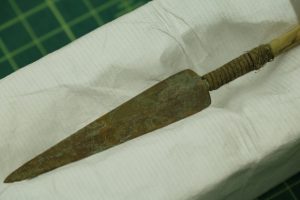Archaeologists travelling with a documentary crew have discovered a nearly 1,000-year-old hunting artefact, half exposed in a remote patch of ice near Carcross, Yukon, North-West Canada.

The archaeologists Greg Hare has been travelling with the crew to some of sites where he and other archaeologists have been finding ancient First Nations hunting weapons over the last 20 years. While waiting on the ice patch for the camera crew to film a group of caribou, Hare and his team spotted an antler arrow point half buried in the ice. It looked like it had just been fired from a bow. After having been pulled from the ice it turned out that the weapon has a copper end blade attached. Analysis of the artefact has revealed that it was made of a copper nugget and is 99.9 percent pure.

Recent radiocarbon dating of the copper arrowhead pegs it at 936 years old, meaning it would be among the earliest examples of bow and arrow technology ever recovered in Yukon. According to specialists the artefact is one of the oldest copper elements that we ever found in the Yukon. Copper only first shows up in the Yukon about a thousand years ago and this is almost at the beginning of that technology.

(after Mike Rudyk, Yukon government & CBC News)